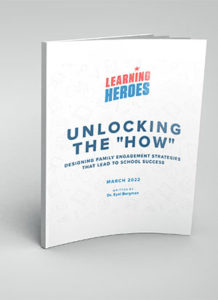Three Pillars of Effective Family Engagement
Walter P. Carter Elementary / Middle School in Baltimore, MD, is in the midst of a transformation. Today, 40% of its middle school students are reading at grade level, compared with fewer than 10% when the school year started. While there is clearly more work to do, principal Brandon Pinkney credits his team’s focus on families as the primary driver for improvement.
Under his leadership, the school began to develop a robust family engagement strategy that touches on every aspect of the school. To build relationships, he implemented Parent Teacher Home Visits and re-designed the master schedule so that every teacher has 30 minutes per day for family office hours. But the school doesn’t stop at relationships. Teachers and families set shared goals, they listen to each other, and they hold each other accountable. This is the promise of strong home-school partnerships.
 Learning Heroes’ recent report, Unlocking the “How”: Designing Family Engagement Strategies that Lead to School Success, highlights stories like Walter P. Carter from around the country. The report builds on years of research to recommend three pillars for an effective family engagement strategy that drives improvements in student learning and well-being.
Learning Heroes’ recent report, Unlocking the “How”: Designing Family Engagement Strategies that Lead to School Success, highlights stories like Walter P. Carter from around the country. The report builds on years of research to recommend three pillars for an effective family engagement strategy that drives improvements in student learning and well-being.
Place trust and teamwork at the center. At schools like Walter P. Carter, staff members know that they have much to learn from families, and this goes a long way toward building trust. Their home visits were a particularly important strategy because they helped teachers understand families’ hopes and dreams for their children and make important connections between home and school. As I write in Unlocking the “How,” what makes home visits so powerful is that they upend traditional power imbalances between home and school.
“Educators usually engage with families in places that are more comfortable for them and on topics more familiar to them, which places a burden on families to go beyond their comfort zone to connect with educators. Flipping this dynamic encourages families to open up and collaborate because they often want to reciprocate teachers’ special efforts to build a different type of relationship.”
This is what I saw when I did home visits with my own students, and why I believe home visits are the best family engagement PD for teachers. Nothing teaches educators about family engagement more than families themselves.
Anchor family engagement strategies in student learning and well-being. Learning Heroes’ nationally representative surveys show that families want a clear and honest picture of how their children are doing academically, socially, and emotionally. However, there remains a significant gap between how families think their children are doing and the reality: 92% of parents said they think their child is at or above grade level, while only 44% of teachers say their students are prepared for grade-level work. In Carter’s home district of Baltimore City Public Schools, the pandemic recovery plan calls for Student Learning Plans for every student, co-created with families and students.
Build a family engagement infrastructure. Teachers in our surveys report that time is the most valuable resource to support family engagement and the least likely pillar to be in place. Given the lack of training and attention to family engagement in schools, systems need to put in place new structures, like Principal Pinkney did at Carter, that serve as a scaffolding to support adult learning over time.
My view is that home visits can be catalytic if staff have time to unpack what they learn about families and themselves. As I write in Unlocking the “How”:
“Research has shown that families felt more comfortable and confident engaging with school staff after a home visit, and teachers who hadn’t previously ventured into the community recognized deficit-based assumptions they had about students and families. Everyone has biases. It is part of being human. What these experiences show is that we are more likely to examine them critically through real-life experiences that touch on the people we care about most – in this case, our students.”
When staff have the time and the training, and their districts have standards, expectations, and senior-level positions driving this work, we can get to the formula that elevates family engagement as a true engine for equity.
 Eyal Bergman, Ed.L.D., is Senior Vice President at Learning Heroes. Dr. Bergman leads Learning Heroes’ capacity-building efforts for school and system leaders. Previously, he was the Family & Community Engagement Officer in the Cajon Valley Union School District. In addition to Unlocking the “How”: Designing Family Engagement Strategies that Lead to School Success, he recently co-authored two pieces with Dr. Karen Mapp: Embracing a New Normal: Toward a More Liberatory Approach to Family Engagement and the Dual Capacity-Building Framework for Family-School Partnerships (Version 2). Eyal’s work and views are shaped by his professional roots in community organizing and youth mentoring, as well as his personal upbringing in a bilingual Latino immigrant home.
Eyal Bergman, Ed.L.D., is Senior Vice President at Learning Heroes. Dr. Bergman leads Learning Heroes’ capacity-building efforts for school and system leaders. Previously, he was the Family & Community Engagement Officer in the Cajon Valley Union School District. In addition to Unlocking the “How”: Designing Family Engagement Strategies that Lead to School Success, he recently co-authored two pieces with Dr. Karen Mapp: Embracing a New Normal: Toward a More Liberatory Approach to Family Engagement and the Dual Capacity-Building Framework for Family-School Partnerships (Version 2). Eyal’s work and views are shaped by his professional roots in community organizing and youth mentoring, as well as his personal upbringing in a bilingual Latino immigrant home.

